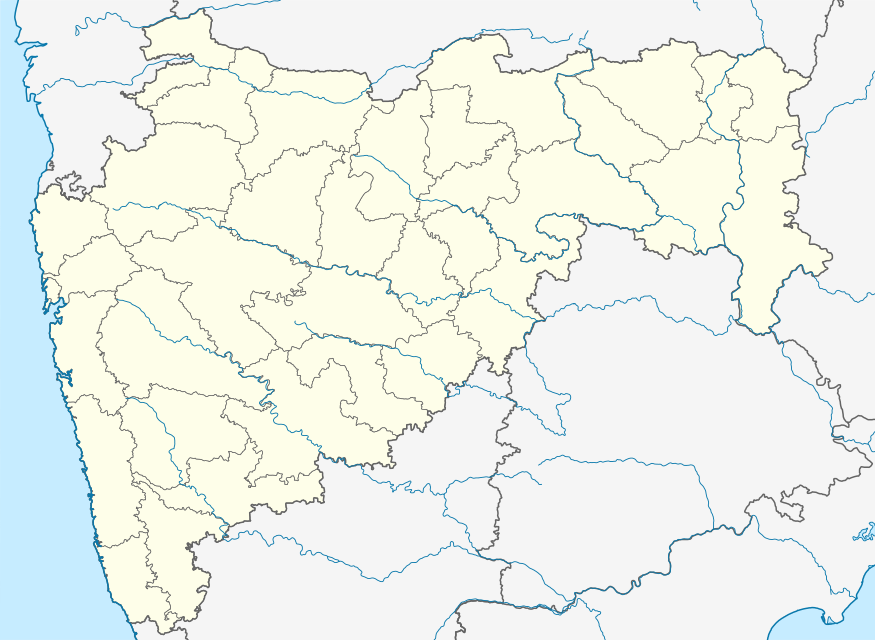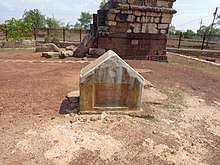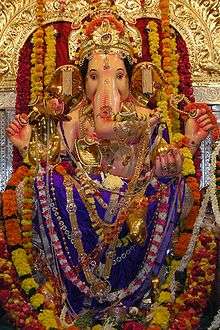Nagbhid
Nagbhid, also known as Nagbhir, is a town and a municipal council in Chandrapur district in the Indian state of Maharashtra. It Connected to NH-353D and MSH-9.
Nagbhid | |
|---|---|
town | |
 Nagbhid Location in Maharashtra, India | |
| Coordinates: 20°35′0″N 79°40′0″E | |
| Country | |
| State | Maharashtra |
| District | Chandrapur |
| Government | |
| • Type | Municipal Council |
| • Body | Nagbhir Municipal Council |
| Population | |
| • Total | 25,234 |
| Languages | |
| • Official | Marathi |
| Time zone | UTC+5:30 (IST) |
| PIN | 441205 |
| Telephone code | 07179 |
| Vehicle registration | MH34 |
| Lok Sabha constituency | Gadchiroli-Chimur |
| Vidhan Sabha constituency | Chimur-Nagbhid |
| Civic agency | Tehesil |
The town is known for the Shiva temple which is located on the hills (Mahadeo chi tekdi or Shiva tekdi, called locally) on the western part of the town. The City is a central place on the NH-353D (Nagpur-Nagbhid-Armori) and MSH-9 (Nagpur-Umred- Nagbhid- Sindewahi - Mul- Chandrapur). Town once upon a time was very known for very high-quality silk(kosa), wool (ghongda-woollen blankets), now only known for high-quality rice. town is now governed by municipal council formed in year 2016, combining 10 surrounding villages in the outskirts of the Nagbhid. The population of the municipal council region is 25234 (census 2011).
History

Prehistoric paintings in the caves have been found near Nagbhid-Palasgad hills proving the human presence of more than 10,000 years. There are many stone Menhirs in the western part of the town at hill base. Around 12 can be seen in rows. Young researcher Amit Bhagat has recently discovered around hundreds of menhirs at Dongargaon, Navkhala, Kasarla & Korambi in the close proximity of Nagbhid.[1] Some researchers have related them to the 3000-year-old megalithic custom of erecting a stone pillar at the burial place. But these stones need more research and preservation.
A village called "Deotak" or Devtek is 2–3 km from Nagbhid, There was a stone slab containing two distinct inscriptions, the characters of one being of the kind known as those of the 'Ashoka' edicts and those of the other belonging to the 'Vakataka' period. Both of them are fragmentary but mention a name Chikambari, which Mr Hira Lal has identified with Chikmara, a village close to Deotak. The slab has now been removed to the Nagpur Museum.
Nothing much is known about the founder and time of foundation for this place. British records go back till 1850 when it had a population of 4000 and a reputation for its good quality 'tussar silk' which was then exported to Europe. Records of export can be found in British market surveys of that time.
Language
The local language in town is Marathi however, people can understand and speak Hindi and English. The Marathi spoken here is "Zadi" Marathi, widely spoken in Vidarbha region. The communities like Halba, Kosti, Dhangars have their own languages but speak Marathi fluently.
Economy and trade
The economy of the town is mainly agriculture-based with a major population is either farmers or farm workers. The portion of the population constitutes government employees in schools, college, tahsil office, railway employees, panchayat samiti employees. The part of community is of merchants & industrialists. Among businesses are rice mills, poultry farms, oil mills, agriculture product trading and retail market. Every Thursday it holds weekly bazaar wherein people from surrounding villages bring their agriculture produce like grains, vegetable, fish for sale. There are a vegetable, mutton, chicken and fish markets which supply good quality fresh products. Town still has age-old communities of Potters (Kumbhars), Farmer(Kunbi), Ironsmith (Lohar), Goldsmiths (Sonar), Shepherds (Dhangar), Silk Workers (Kosti), Oil Producers (Teli), Barai, Carpenters (Sutar), Varthis, Dhiwar gives this town an essence of old culture.The town is surrounded by fresh water lakes like Nawkhala, Ghodazari, Kasrla which supplies fresh variety of fish (Vaghur, Rohu, Katla, Prawns, botre, katwe etc.).
Religion
The town has people of Hindu religion in the majority with next major religion being Buddhist and Muslims, other religions are less. Town has temples of Shiva, Vitthal mandir, Shri Ganesha temple, Ram Mandir, Chavdeshwari Mandir, Ganga mata temple and small Hanuman temples at various places in town. There is one Budhha Vihar, and Parmatma ek, Om Shanti Centre, too. Also, the town has three mosques, one of raza sunni jamat, one of wahabi jamat and one of agakhani ismaily jamat. There is also a church.
Transport
Town has now come up over the national highway map after formation of National highway 353D connecting Nagpur to Armori. Nagbhid is almost equidistant from surrounding district headquarters. It is well connected by roads (Nagpur 97 km, Chandrapur 104 km, Gadchiroli 80 km, Bhandara 80 km, Wardha 120 km and Gondia 130 km) . It forms a center over Nagpur-Gadchiroli highway. Nearest commercial airport is Nagpur.
Railway
Nagbhid town is served by Nagbhir Junction railway station. Nagpur-Nagbhir is a narrow gauge route of 110 km which connects to Gondia- Balharshah route at Nagbhir Junction railway station. Gondia- Balharshah line was converted to broad gauge in 1999. Conversion to broad gauge of Nagpur-Nagbhir line has been approved and is expected to commence soon.[2]
There is a railway colony adjacent to the station which has a garden, children's park and a good playground. This colony is surrounded by 350 acres empty land belonging to railways which may be useful for the railway industry, store or workshop if planned well.
Tourism
The town is surrounded by jungle with lakes and temples. Ghodazari Wildlife Sanctuary is 10 km from Nagbhid and 100 km from Nagpur and Chandrapur. Ghodazari is a small lake surrounded by nature and forest. Due to recent conservation efforts, the number of wild animals is on the rise. It is common to see tigers, leopards, sloth bears, bison, spotted deers, wild boars in the jungle surrounding at the western edge of Nagbhid. Local newspapers often carry news articles on human-wildlife conflict leading to domestic cattle and human deaths. Other tourist places of interest near Nagbhid are Pandav caves (2000 year old carved caves), Adyal tekdi (temple complex set by Rashtrasant Tukdoji Maharaj), Gaymukh temple, and Satbahini temple (with prehistoric human paintings in caves).
Shiv Tekdi
Shiva temple at the hill trusty Kamunwar family now declared as a Government category C tourist center, which gives a religious peace of mind. A view of town can be seen from the temple over the hill. some other smaller temples and a huge and a statue of Lord Shiva (20 meters) has been built recently. Now it is taking a shape of temple complex with good garden around it.
Facilities for tourists
Nagbhid is well connected to nearby cities by roads and railways and is always peaceful. Local cars from tourist services can also be hired. Town now has a jungle resort (Nisargayan) situated in the jungle between the hill and a lake. Other lodging and boarding facilities including garden restaurants are available now. All major govt banks have their ATMs in the town.
The town has Government offices like Tahsil Office, Panchayat Samiti, Railway office, R&B, PWD office, irrigation department, Banks like Bank of India, Maharashtra bank, State Bank of India, Chandrapur District Co-operative banks and Grihalaxmi mahila sahkari bank, Want aadkuji aquamarine patsanstha, Swami Vivekananda sahkari patsanstha, Samyak sahakari patsanstha, Sant Tukaram Nagari Sahakari Patsansth & other small co-operative banks for finance.
Medical facilities
The town has a tradition of good ayurvedic vaidyas in a 19th and 20th century like shri Nagorao Vigam, Shri Ganpatrao Bikkewar Vaidya, Shri Shridhar Vaidya. At present town has a good Gynaecologist Dr Ashish Selokar, pediatrician Dr Vijay Kale and physician Dr Shivankar. Good Allopathic general practitioners are available like Dr Nabatosh Biswas, Dr Harish Bagade, Dr. Diwakar Chilbule and Some good Homeopathic practitioners like Dr Anant Dachewar, DrAzeez [Azam] Dhamani and some new practitioners are also working. Recently some dentists and opticians has started their well-equipped hospitals here. The town has a Government Rural Hospital and pathological diagnosis centres with an updated infrastructure. The town has a number of good medical stores. Few of them are quite old in the town like Kabra, Pandharinath, Dev, Warjurkar and Singh medical stores. All these facilities grab the interest of nearby villagers.
Education
Nagbhid has three primary schools: Basic primary School for boys, Kanya Shala for girls and Saraswati Vidya Mandir for boys and girls from 1st to 4th standard. There are three convents: Twinkle English school, Little rose convent, and Royal public school Hindu Dnyanpith shishu Mandir & recently started Janata English Convent & Karmveer English Convent imparting semi-English medium education. From 5th to 12th town has three schools, junior high schools, "'Janata Vidhyalaya/junior college"'.for Boys/Girls, Janata Kanya for only Girls, Karmveer Vidhyalaya / Junior Arts and Science college with co-education. Nagbhid has an Industrial training Institute (ITI), and two senior colleges: Shri Govindrao Warzurkar offers graduate courses in Arts and commerce, and Manoharbhai Shikshan Prasarak Mandal Armori's Mahatma Gandhi Arts and Science College offers graduate courses in Arts and Science. The town also has two D.Ed and B.Ed colleges. Recently a school for the mentally retarded and for the deaf has been started with a hostel facility. For higher education in Science, Engineering, Medical or medicine, law students go to nearby cities like Bramahapuri, Nagpur or Chandrapur.
Governance
Nagbhid comes under Chimur-Gadchiroli Constituency, Ashok Nete (BJP) is Member of Parliament for Gadchiroli–Chimur constituency. For state legislature, Nagbhid comes under Chimur-Nagbhid constituency and Bunty Bhangdiya is the member for the Maharashtra Legislative Assembly. The town is politically active and have a mix of supporters for Indian National Congress, NCP, BJP, Shivsena, Republican party.
Agriculture and literature
Dadaji Khobragade, a scientist who researches rice varieties, is from Nanded village in Nagbhid tehsil. He is the only person in the area to have been awarded by President of India. The main crop in the area is rice due to the suitable climate for paddy. Other crops like varieties of wheat, gram, pulses (like tuvar, lakhori, mung, udid), vegetables, fruits like berries, mangos, guava are also produced.
Literature
Sanjay v. Yerne creat A unique record of writing and publishing of a novel on the historical and life style of shri sent santaji jagnade maharaj and his wife Yamuna This novel is based on the work and life style of the maharashtrian saints this novel is based not only on the work and life style of the maharashtrian saint but also on the research of historical incidents during the period of 1624 to1700. Nobody has written and publish a book before on saint Santaji jagnade and his wife Yamuna. the name of those unique book 1] "shri saint santaji maharaj :A warrior" 2]"Yamuna- Life shaddow of sent santaji jagnade" These novel has been written and published in marathi language These novels have made people know the information for the first time on lifr style of saint santaji jagnade maharaj and his wife yamuna not only in maharashtra but also India.
Festival and specialities

Nagbhid being mixed of all religions celebrates all festivals of Hindus, Muslims and Bhudhism. People get involve in celebrations of these festivals. The major festivals like Diwali, Dushera, Holi, Janmashtami (Birthday of lord Krishna) pola, Id Muhrram are celebrated in the town. Special festivals like Mahashivratri, Ganesh Chaturdashi, Mahalaxmi Pujan (Jeshtha Gauri Pujan) Navratri (Durga Puja), Sharda Puja, Nagpanchami, Sankrant are also celebrated in the town. Ganesh Chaturthi and Mahalaxmi Festival are commonly celebrated in Nagbhid. There are several Ganesh Mandals in Nagbhid who celebrate this festival with huge response. Also Ganeshchaturti is celebrated at many homes in this village.
Burning of an effigy of 'Ravana' on the occasion of Dushera is a tradition of the town for years together.
On Holi, on day one holika dahan takes places at many places on in the town and the next day is celebrated as Rangpanchami i.e. festival of colours.
Pola is one of the major festival in the town which is generally celebrated in Vidharbha region of Maharashtra. This is the festivals of bullucks which are used by farmers in the farms and are an integral part of the life of farmers. Bullocks are decorated, worshiped on the day. The pair of bullocks are displayed in the local market. Next day is celebrated as tanna Pola, in early hours of morning procession of a 'Marbat', the symbol of evil spirits taken all along the street of the town and then dispersed outside the town, indicating removal of bad habits and evil spirits.
Tanna Pola, i.e. Pola for children wherein children display small bullocks toys made of wood also called as Nandi bail and a procession is taken all around the town.
Nagbhid is among the few places where Mahashivratri is celebrated on a large scale. In the morning hours people in the town go to the Shiva Temple which is located on the hills on the outskirt for worship. At the bottom of the hill, there is a fair. In the evening a procession of "Nandi" (10–12 feet tall effigy of a bull on wheeled chariot) also called Nadi Rath, who is worshiped as carrier of Lord Shiva starts from the house of late 'Shri Gajananrao Kamunwar' to the base of Shiva hills (Mahadeo chi tekdi, called locally) and kept there for display for two weeks, during these two weeks the weekly bazaar is held at the base of the hill.
There are some festivals called 'Jivti' which might have lost relevance in today's world but is still celebrated in Nagbhid. Dushera festival is a typical celebration where GOLD is distributed by the people, surprised, The leaves of a tree called SHAMI, or 'shamipatras' are exchanged as gold on the occasion of Dushera after burning effigy of Ravana or Ravan Dahan, as a symbol of conquer over capital of Ravana Shri Lanka, supposed to be made of gold, by Shri Rama a Hindu deity. The other part of the story is that when Pandavas in Mahabaharta went for Vanvas they hid their weapons on the tree called Shami hence shami patras.
Janmashtami – the Birth day of lord Krishna is also celebrated in most of the homes. In the Janmastami people buying the idol (Murti or Stachu) of Lord Krishna and Radha from the market and installed (sthapana) in a home in this auspicious event the next day people arrange the small Dahi handi programme and sing the devotional song of Lord Krishna. After completion of the Dahi Handi event, the idol of Lord Krishna is immersed in water.